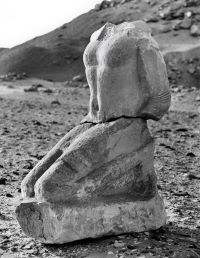
09
JulARCE Chicago: Beheaded Foreign Foes: King Pepi I’s Prisoner Statues
Registration is required
Presented by: Tara Prakash, Assistant Professor, College of Charleston
- 5:00 PM CDTIllinois
- In-person/ZoomLa Salle Banks Room at the Oriental Institute, University of Chicago
- + Add to Calendar
Lecture Abstract:
During the late Old Kingdom, six different pharaohs erected nearly life-size, limestone statues of kneeling, bound captives inside their pyramid complexes. These statues are commonly known as prisoner statues, and they were a major part of the monument’s decoration. This talk will focus on the prisoner statues of King Pepi I. These prisoner statues were highly unusual in two important ways. First, they portray generic foreign enemies rather than specific ethnicities, as is typical in Egyptian art. Secondly, the statues were never meant to remain intact; instead, Pepi I’s artists methodically decapitated and butchered them. In their decapitated form, Pepi I’s prisoner statues were ritual offerings and monumental images of the deceased king’s annihilated enemies.
Speaker’s Bio:
Dr. Tara Prakash is an assistant professor at the College of Charleston. She received her PhD from the Institute of Fine Arts, New York University with a specialty in the art and archaeology of ancient Egypt. Dr. Prakash has held postdoctoral fellowships at the Metropolitan Museum of Art and Johns Hopkins University, and she previously was the W. Benson Harer Egyptology Scholar in Residence at California State University, San Bernardino. Her research focuses on issues of ethnicity and identity, foreign interactions, artistic agency, and the visualization of pain and emotion in ancient Egypt. Her forthcoming book is the first comprehensive study on the prisoner statues, a unique series of Egyptian statues that depict kneeling bound foreigners.
Photo Credits:
Prisoner statue heads from the pyramid complex of Pepi I (Courtesy of the Mission archéologique franco-suisse de Saqqâra)
Prisoner statue body from the pyramid complex of Pepi I (Photograph: Mario Carrieri, Milan/The Menil Foundation)

